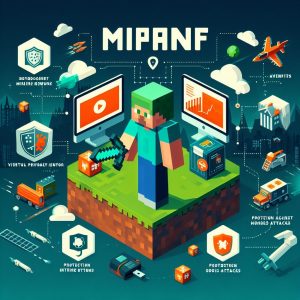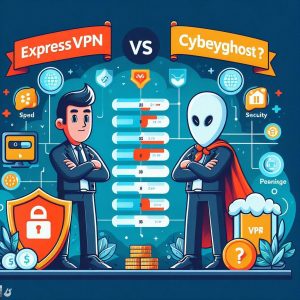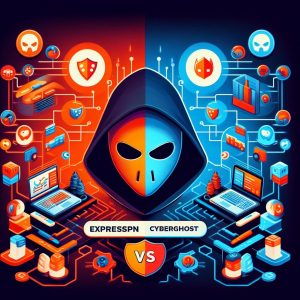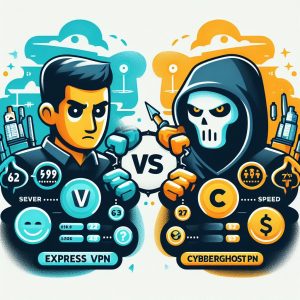I. Introduction
With over 140 million monthly active users as of 2022, Minecraft has solidified itself as one of the most popular video games ever created. The simplistic nature of Minecraft allows for endless creativity, letting players construct anything they can imagine one block at a time in a virtual sandbox world.
However, to fully unlock the potential of Minecraft and have the optimal gaming experience, using a VPN (virtual private network) is highly recommended. A VPN can provide a number of benefits that enhance gameplay, security and accessibility for Minecraft users.
This comprehensive guide will discuss what a VPN is, the advantages of using one for Minecraft, review the top VPNs for Minecraft, provide a setup tutorial, and give recommendations for choosing a suitable VPN for your needs. By the end, you’ll understand how to leverage VPN technology to get the most out of playing Minecraft.
II. What is a VPN and Why Use It for Minecraft?
A VPN, or virtual private network, is a service that encrypts your internet traffic and routes it through a server in a location of your choosing. This protects your data and online identity by masking your IP address and establishing an encrypted tunnel between your device and the VPN server.

There are several key benefits to using a VPN for Minecraft:
A. Bypass IP Bans
Minecraft servers can ban certain IP addresses from connecting, which can prevent you from playing if you get IP banned. A VPN allows you to change your IP, so you can bypass such bans and continue accessing Minecraft servers.
B. Prevent DDoS Attacks
Unfortunately, distributed denial-of-service (DDoS) attacks are common within the Minecraft community. A VPN hides your home IP address, making it much harder for attackers to target you with DDoS floods, keeping your connection safe.
C. Access Geo-Blocked Content
Some Minecraft servers, mods, and content may be restricted based on your geographic location. Connecting via a VPN server in another country allows you to bypass these restrictions.
III. Best VPNs for Minecraft
When it comes to choosing a suitable VPN for optimizing your Minecraft experience, there are a few key factors to consider:
- Fast speeds with low latency for smooth online multiplayer gameplay.
- Reliable connections and minimal downtime so you can play uninterrupted.
- Servers located near Minecraft servers to reduce ping.
- Ability to bypass VPN blocking measures on some servers.
- Strong security and encryption protocols to keep your traffic safe.
Taking these criteria into account, below are our top recommendations for the best VPNs for Minecraft.
A. NordVPN
NordVPN is arguably the most popular consumer VPN on the market, and for good reason. With over 5400 servers worldwide, super-fast speeds, and robust security, it’s an excellent choice for Minecraft.
1. Features and Benefits
NordVPN has a range of features ideal for gaming, including CyberSec malware blocking, Double VPN for extra encryption, and Onion Over VPN for added anonymity. There’s also a handy built-in VPN server tester and filter to help find the fastest connections for gaming.
2. Server Network and Speed
You can easily connect to servers near Minecraft servers to get lower latency. NordVPN has high-speed servers located all around the world, so lag will rarely be an issue. Speeds are consistently fast and reliable.
3. Ability to Bypass VPN Detection
NordVPN has specialized obfuscated servers that can bypass VPN blocking measures on some Minecraft servers for unrestricted access.
B. Surfshark
Known for its unlimited device support and lively branding, Surfshark is a newer VPN that has quickly become popular for gaming thanks to its fast performance.
1. Unlimited Device Connections
Unlike most VPNs, Surfshark places no limit on the number of devices that can use one account simultaneously. You can secure all your gaming devices with a single subscription.
2. Access to Static IP Addresses
Surfshark offers access to private static IP addresses for each server location. This improves connectivity speed vs the commonly used dynamic IPs on other VPNs.
3. Fast Speeds and Great for Streaming
Based on testing, Surfshark has proven to offer some of the fastest VPN speeds across its network, with minimal lag or buffering. This makes it great for streaming and gaming alike.
C. ExpressVPN
ExpressVPN is a longtime favorite VPN for various uses, including gaming and Minecraft. The combination of rapid speeds, reliability, and security make it a go-to choice.
1. Speed and Reliability
With high-speed servers in 94 countries, ExpressVPN offers extremely fast and stable connections crucial for online Minecraft play. There’s virtually no lag or downtime.
2. Gaming-Optimized Servers
ExpressVPN operates servers that are optimized specifically for reducing ping times in online games like Minecraft. This results in a smoother, more responsive gameplay experience.
3. Protection Against DDoS and ISP Throttling
ExpressVPN servers mask your IP address and make your traffic anonymous. This adds protection against DDoS attacks, and prevents ISP bandwidth throttling which can slow your connection.
D. CyberGhost
While not as fast as others on this list, CyberGhost excels when it comes to blocking dangerous websites and staying anonymous.
1. Beginner-Friendly but Powerful
CyberGhost has an easy-to-use interface that makes it very approachable for VPN novices. But beyond the surface, it offers advanced features and security for power users as well.
2. Dedicated Gaming Servers
To reduce latency while gaming, CyberGhost offers servers dedicated to gamers that route traffic for the lowest ping times while playing.
3. Affordable Pricing
CyberGhost offers reliable VPN protection at one of the most budget-friendly price points on the market.
E. Private Internet Access (PIA)
Private Internet Access has been building out its VPN service with gamers in mind, striking an excellent balance between speed and security.
1. Good and Stable Connection Speeds
PIA has high-speed VPN servers worldwide, and general performance is fast enough for gaming without significant lag or ping spikes while connected.
2. Benefits for VPN Newbies
PIA’s apps and software are easy to install and understand, with built-in auto-connect features. This makes it very beginner-friendly.
3. Dedicated NoSpy Servers
To better protect user privacy, PIA offers NoSpy servers in Germany and Spain that prevent geolocation tracking and collection of traffic metadata.

IV. How to Use a VPN for Minecraft
Using a VPN with Minecraft is a straightforward process across Windows, Mac, iOS, Android, and other platforms. We’ll outline the basic steps for getting set up:
A. Step-by-Step Setup Guide
- Select and subscribe to a suitable VPN provider from our recommendations above, and download their app.
- Install and open the VPN app, and log in with your account details.
- Connect to a VPN server location geographically close to your Minecraft server for the best latency.
- Check your new IP address within the VPN app to confirm your traffic is now routed through the VPN tunnel.
- Launch Minecraft as normal once connected to the VPN. You can optionally enable VPN split-tunneling if you only want Minecraft traffic protected.
- Verify you are still connected to the VPN within the app while playing Minecraft. Enjoy your optimized VPN-boosted gameplay!
B. Specific VPN Setup Tips
- NordVPN: Select VPN server locations using the Speciality Servers > Gaming filter to find locations ideal for Minecraft.
- Surfshark: Use the MultiHop feature to route through multiple VPN servers for added security.
- ExpressVPN: Connect using their MediaStreamer DNS service to unblock geo-restrictions on content.
- CyberGhost: Use the Settings menu to enable VPN traffic for specific apps like Minecraft.
- PIA: Toggle on the Next Generation Network feature within Settings to enable improved performance.

V. Considerations When Choosing a VPN for Minecraft
To select the best VPN for your specific needs and setup when playing Minecraft, keep the following factors in mind:
A. Server Network and Speed
A fast, low-latency connection is the top priority. Test various VPNs to compare speeds, looking for consistently fast servers near your location.
B. Ability to Bypass VPN Blocking
Some servers try to block known VPN IP ranges. Using NordVPN obfuscated servers or Surfshark’s IP shuffle feature will bypass these restrictions.
C. Security Features and Encryption
A VPN that uses strong 256-bit AES encryption, a reliable kill switch, and perfect forward secrecy for keys will keep your connection ultra-secure.
D. Device Compatibility and Simultaneous Connections
Being able to secure all your devices with one VPN account is convenient. Surfshark places no limit on simultaneous device connections.
VI. Conclusion
In summary, using a quality VPN for playing Minecraft is one of the best ways to optimize your connection speed, security, and accessibility. Follow our guide to get set up with a top-rated VPN for the best Minecraft experience.
Key takeaways include:
- Use NordVPN for avoiding IP bans, ExpressVPN for lowest latency servers, and Surfshark for unlimited device connections.
- Connect to VPN servers geographically near your Minecraft server location to reduce ping and lag.
- Select a VPN with robust encryption, unlimited bandwidth, and high speeds to enhance security and performance.
By leveraging a VPN like the options covered above, you can unlock the full potential of Minecraft through an encrypted, anonymous internet connection that bypasses restrictions. A world of creative freedom awaits!
Introduction
Aircall’s cloud-based call center software furnishes growing teams configurable calling capabilities aligned with customized service benchmarks necessary upholding standards however ambitions expand. But suboptimal integrations, transitional growing pains noted in some experiences and asymmetric global pricing packed in opaque quoting fuels interest in alternatives matching needs should shortcomings surface. This guide surveys Aircall’s fiercest rivals vying for market share.
Evaluation Criteria
Assessing ideal Aircall alternatives weighing prospective virtues against any limitations relies on a combination of factors:
Pricing – Balance expected features with fair value and flexibility allowing bi-directional scaling responding to shifting demands.
Features – Determine must-have calling tools like IVR menus, omnichannel queues or contact center insights and compare depth versus competitors.
Ease of Use – Evaluate interfaces and configuration processes emphasizing simplicity enabling agents providing quick customer issue resolution.
Support – Review setup assistance, staff training, and ongoing troubleshooting responsiveness which greatly aids adoption.
Reliability – Uptime history reflects infrastructure stability with direct impact on revenue and operations continuity.

Top Aircall Alternatives
Dialpad
Touted as an elite business communications platform blending voice, meetings, messaging and contact center functionalities behind an AI-powered interface, Dialpad strives towards frictionless interoperability across essential tools fueled by automation.
Pricing
Dialpad shines through all-inclusive pricing bundling unlimited user calling, meetings, messages and team SMS under a consistent per-seat subscription starting from $25 monthly appealing to streamlined deployment preferences.
Features
True unicorns like Voice Intelligence auto-transcriptions, real-time sentiment analytics gauging call performance and built-in CRM understand nuance and context adjustable around insights. Salesforce integrations also unite datasets.
Verdict
Dialpad convinces as a market leader pioneering human-like intelligence capabilities assisting agents and informing strategic decision-making through actionable analytics.
JustCall
Promising 5-minute rapid account activations, JustCall markets itself as an intuitively designed cloud-based call center catering from fledgling teams to large enterprises across integrated voice, social media and web channel engagement powered by configurable rule-based routing.
Pricing
JustCall impresses through competitive pricing including a forever free plan for startups managing 20 customer conversations daily. Unlimited paid plans scale from $30 per agent monthly baking inclusive call recording tools and CRM synchronization.
Features
Standouts like multilingual chatbots scale initial engagements while customizable IVRs guide omni-channel issue resolutions. APIs also allow unique workflows integration while real-time call monitoring powers coaching.
Verdict
JustCall warrants consideration from growing teams prioritizing seamless omnichannel customer experiences underpinned by aggregated visibility into interactions for identifying service gaps.
CloudTalk
Offering an elite blend of simplicity meeting enterprise-grade customer engagement capabilities, CloudTalk pitches one platform neatly handling essential calling tools spanning IVRs, readymade templates and customizable call flows equipped to launch sophisticated outbound/inbound campaigns with drag-and-drop widgetry saving managers hours.
Pricing
Subscriptions start free for startups facilitating 100 monthly minutes sufficient testing while paid upgrades incur usage-based charges atop affordable per agent fees allowing high-volume campaigns. Enterprise customization agrees larger needs.
Features
Deep Salesforce, Slack and G Suite tighten system integration. Prominent real-time call monitoring dashboards readily identify coaching moments through smart insights and areas needing optimization to align staff while raising satisfaction benchmarks.
Verdict
CloudTalk edges smaller competitors on integrations depth and insightful analytics sophistication easing large team alignment around elevated service objectives fulfilled through purposeful tools configuration simplicity absent overwhelming setup delays hampering launch.

Nextiva
Increasingly prominent furnishing large enterprises customizable cloud communications functionalities blending reliability, automation, transparency and award-winning support spanning impatient segments, Nextiva streamlines technical complexities implementable by non-specialists.
Pricing
Subscriptions covering calling, meetings and contact center capabilities start from $18.95 per month per user anchored by reliable 24/7 live support access and adjustable up or down responding to needs.
Features
Notable inclusions like shared business SMS lines allowing team oversight, context preservation with threaded messaging and real-time call monitoring dashboards accelerate information flows keeping staff collectively informed handling inquiries.
Verdict
Nextiva warrants shortlisting by discerning managers seeking integrated platforms handling the breadth of call handling, untethered mobility support and essential digital channel facilitation at friendly rates matched by renowned customer care.
RingCentral
Increasingly seen as an inextricable market leader servicing small establishments to large multination enterprises seeking cloud communications ecosystem uniting essential calling tools under an AI-optimized umbrella, RingCentral furnishes reliable scalability managing up to 10,000 employees as demands evolve.
Pricing
Subscriptions cover the breadth of capabilities from domestic dialing and automated attendants to omnichannel contact centers and advanced custom app development priced from $19.99 per month attractively serving smaller teams.
Features
Intuitive call management aesthetics persist from vanilla offerings to enterprise-grade deployments assisted through guided onboarding resources accelerating rollouts. Generous API libraries also expedite ecosystems integration tailoring workflows.
Verdict
RingCentral convinces as a mature industry staple continually innovating through global partnerships bedrocking reliable omnichannel engagement solutions suited for essentially any ambition scale.
Freshdesk Contact Center Software
Promising enterprising teams feature-rich yet affordable customer support capabilities tightly integrating assistance functionalities into broader operation stacks through its mainstay help desk product lines, Freshdesk contact center solutions enable personalization capabilities furthering customization.
Pricing
Competitively priced tiers structure charging per agent monthly, including $15 per rep plans furnishing fundamentals up to $50 for unmetered premium providing Satisfaction Score call analytics.
Features
Omnichannel queues with skills-based intelligent call routing optimize human resources allocation matching top agents to caller needs for raising first contact resolutions while reducing handle times.
Verdict
Freshdesk earns recognition bundling cost-effective yet sophisticated tools assisting managers constantly refine strategies responsively upholding and scaling elevated support pledge through purposeful resourcing, gaps identification and iteration.
Zendesk Talk
Promising an elite call center software melding exceptional reliability, rapid implementation measured in hours and mobile-native omnichannel facilitations, Zendesk Talk positions itself as a natural upgrade path for existing Talk help desk users seeking tight feature integration managing end-to-end support workflows across channels .
Pricing
Competitive monthly per-agent pricing starting from $20 per month allows smaller teams entrance while enterprise quotas achieve bulk discounts alongside the breadth of capabilities spanning IVRs to real-time analytics.
Features Highlighting productivity optimization, functionality like Agent Assistant tapping historical case patterns for suggested best next actions guides interactions while still permitting overrides protecting human discretion matching unique case nuance. CRM augmentation also enriches call context.
Verdict Zendesk Talk warrants consideration from growing startups and sprawling enterprises alike as a pillar of customer support platforms leveraging data insights and machine learning to unlock agent performance fulfilling elevated satisfaction pledges.

Twilio
Long prominent furnishing reliable cloud communications building blocks essential satisfying crucial consumer engagements milestones, Twilio empowers technical leaders architecting customized customer experiences solutions through its readily programmable SMS, Voice and WhatsApp APIs, SDKs and drag-drop UI.
Pricing
Its fine-tuned pay-per-use utility pricing allows high-volume enterprises unlimited scalability and innovation possibilities constrained only by teams’ ambitions and needs from compliant HIPAA secure infrastructure to 2-way SMS facilitations and toll-free international support lines.
Features Myriad Twilio products furnish enterprises reliable cloud building blocks essential satisfying crucial consumer engagements through programmable APIs and SDKs blending voice, messaging and video under compliance-grade security protocols.
Verdict Twilio earns strong backing among engineering-driven teams electing deep custom communications app development assisted by its modular cloud-hosted infrastructure, security support, and usage-priced utility across diverse products enabling specialized innovations.
8×8
Increasingly competing furnishing mid-large entities unified analytics dashboards tracking holistic organization performance across meetings, phone services and contact center engagements built over Jitsi open-source foundations, 8×8 XCaaS communications platform strives easing onboarding promising full-scale deployment within hours.
Pricing
8×8 subscription plans charge per user licensing conveying essential calling capabilities plus bundled meetings and team chat messaging extras starting from $12 per employee monthly alongside volume discounts better agreeing larger deployments.
Features
Standouts features include advanced AI analytics quantifying staff performance with next best actions recommendations based on historical case patterns boosting productivity alongside channels integration consistency conveying interactions histories across engagements touchpoints.
Verdict 8×8 deserves consideration from growing organizations needing foundational business communications functionalities with haste backed by strong analytics extracting performance optimization insights from customer engagements.
Conclusion
In closing, Aircall’s rising challengers lead by Dialpad, JustCall, CloudTalk and Nextiva warrant consideration from discerning leaders requiring enhanced tools facilitating scaled calling volume growth through refined routing matching ideal agents to incoming needs based on smart predictive insights unburdening staff through automation while conveying unprecedented visibility upholding excellence. Carefully evaluate key buying criteria elements to determine solutions aligning best to needs.
Introduction
Selecting the right business phone system constitutes an essential step for small to midsize companies aiming to project professionalism boosting customer engagement. Evaluating leading VoIP platforms like 8×8 and Nextiva on critical pillars around features, pricing, support and security informs smart investments matching organizational needs and growth trajectories. This guide contrasts these top providers across key categories simplifying decision making.
Features
8×8 and Nextiva furnish extensive communications feature sets spanning core IP telephony, call routing functionality to integrated HD video meetings and cloud contact center solutions.
For core phone capabilities, both systems enable unlimited calling, auto attendants, advanced call forwarding tools, and global number provisioning. Nextiva edges ahead with unlimited US SMS bundled by default unlike metered allocations on 8×8.
However, Nextiva pulls ahead for companies prioritizing omni-channel contact center capabilities and unified communications. All tiers embed customer engagement tools like shared inbox, chat widgets, advanced IVRs and visual dashboard analytics suited for sales teams. CRM integrations are also more extensive.
Conversely, 8×8 leads for international organizations through built-in global toll-free numbers and endpoint firmware optimization for sites lacking reliable connectivity. But Nextiva offers better native video meeting utilities including webinars hosting up to 1000 attendees.

Pricing
Nextiva and 8×8 pricing reflect industry-wide shifts towards value-based consumption freeing SMBs from complex user licenses. Entry-level Nextiva packages start from $18.95 per month per user anchored by reliable support access. 8×8 equivalent plans retail slightly cheaper at $14 bringing affordability at smaller scales with margin add-ons.
However, mid-market buyers enjoy greater long-term value from Nextiva’s transparent enterprise pricing model tallying access fees, device rental and unlimited domestic calling in a single quote as functionalities scale up. Nextiva also bundles more minutes for the money on toll-free calling plans vital for professionalism.
Conversely, 8×8 niche options like global toll-free numbers and specialized phones for conference rooms attract specific needs. But Nextiva’s all-inclusive pricing helps avoid surprise hikes as emerging needs trigger add-on fees pricier on 8×8 detracting from forecasting clarity.
Pros and Cons
8×8 Advantages
- Affordable entry-level plans
- Natively supports global customers
- Integrates with popular business apps
8×8 Drawbacks
- Metered SMS quotas and calling minutes
- Support reliability concerns for larger clients
- Transparent enterprise pricing
Nextiva Advantages
- Simplified value pricing
- Bundles unlimited calling and SMS
- Exceptional uptime and support ratings
Nextiva Drawbacks
- Potential complexity scaling all-in-one suite
- CRM requires separate purchase

Customer Support
Strong customer support constitutes a vital selection criterion ensuring productive use. Reviews praise Nextiva’s 24/7 live phone and chat support responsiveness from technically adept reps resolving issues. Users highlight ticket resolution within 30 minutes even during peak volume.
By comparison, 8×8 relies on extensive self-help resources and community forums for initial troubleshooting. But delays assistance tickets and lackluster communication tapering large account onboarding underscore areas needing improvement.
So for Users wanting concierge-style managed services partnership across onboarding, configuration and troubleshooting processes, Nextiva delivers excellence worthwhile for complex deployments.
Security
Both platforms implement robust security protections safeguarding sensitive call data and recordings including PBX encryption, TLS and SRTP protocols. As cloud-native VoIP solutions, infrastructure configurations and patching resides with the vendors, relieving IT administrative burdens monitoring emerging threats.
However, Nextiva does offer two-factor authentication (2FA) for added login protection alongside single sign-on (SSO) integration with major identity providers like Okta securing access. Nextiva also oversees routine external security audits to responsibly discover vulnerabilities before incidents.
So users dealing with compliance standards or handling financial/medical call content retain peace of mind through Nextiva’s airtight security stance.

Conclusion
In closing, while 8×8 and Nextiva both furnish excellent VoIP phone solutions for SMBs, Nextiva pulls ahead based on transparent flat-rate pricing, exceptional reliability statistics, bundled unlimited calling/SMS and stellar support experiences cementing virtues as a premium provider. But 8×8 remains appealing for budget-limited starter plans. Carefully weigh priorities around scale, customer support, and configurability when selecting systems to maximize value protecting communications infrastructure enabling lasting customer connections.
Introduction
8×8 rose to prominence providing reliable, cost-effective cloud communications solutions, including key offerings like VoIP phone services, call center software, and video conferencing. However, it has its share of setbacks ranging from seemingly higher costs, limited configuration options, sporadic outages impacting critical services and occasionally poor customer support responsiveness leading to frustration for some midmarket and enterprise clients reported in online reviews.
Finding alternatives enabling uninterrupted customer engagements with feature diversity matching evolving organizational needs drives the market for services competitive with 8×8. This guide highlights the key capabilities and defining characteristics of top 8×8 alternatives meriting consideration.
Ringblaze
Overview
Offering enterprise-grade products for a competitive fraction of enterprise prices, Ringblaze delivers a comprehensive business communications solution handling telephony, contact center operations, conferencing, and API integrations.
Benefits
Its phone plans scale affordably from basic voice lines supporting a dozen employees to unlimited calling suits better accommodating SMB budgets. Interactive voice response (IVR) further steadies customer engagements alongside call and contact center monitoring.
Video meeting capacities supporting up to 100 participants per conference also outsize comparable offerings while screen sharing and recording foster collaboration. Client dashboard and endpoint integrations including CRMs, helpdesks and other instruments maintain continuity.
Ideal For
The extensive features suite served with quality support makes Ringblaze suitable for small businesses planning long-term growth across various communications capabilities seeking reliable infrastructure without overspending early on.

Ringover
Touted as an elite alternative for cost-conscious growing enterprises yet accommodating smaller operations, Ringover packs an exhaustive range of communications functionalities spanning telephony, call routing, IVR menus, call center management and video conferencing within customizable packages.
Comparison
Contrasted with 8×8, Ringover impresses through more transparent reliable pricing, faster resolution velocities, multi-channel onboarding and implementation guidance contributing to smoother transitions. Enterprise-level packages meet advanced needs while economical tiers align affordability.
From a feature perspective, native integrations through RESTful APIs and CRM connectors streamline workflows alongside intelligent call routing, visual dashboards simplifying insights extraction and administrative oversight.
Verdict
Altogether, Ringover makes a compelling case cementing status as a premier unified comm leader equipping organizations with extreme configurability absent the complexity.
Nextiva
Overview
Positioning itself as a customer-centric carrier blending reliability, transparency and automation, Nextiva furnishes mid-large entities robust cloud communications functionalities from VoIP dialing to omnichannel contact centers backed by exceptional reliability ratings achieving 99.999% uptime reputedly outperforming others as corroborated through customer sentiment.
Contrast With 8×8
Side-by-side comparisons with 8×8 reveal Nextiva edging ahead on pricing clarity, support responsiveness, intuitive self-service portal access and continuity assurances during outages through failover. Unique differentiators like unlimited domestic SMS allocating usage credits, permitting threaded messaging chains unified across devices and toll-free minute bundles surpassing rivals cement virtues.
Considerations
While scaling conversations pose no bound, smaller groups may find sufficient capabilities in other bantam-tier platforms with core telephony needs unrequiring expansive features of Nextiva. However, the overarching transparency and signature vocal customer service merit notable mention.
Vonage
Presenting itself as a new-age carrier furnishing modern communications solutions, Vonage innovates through cutting-edge integrations, smart network enhancements and global connection capabilities catering from modest sized firms to the largest multinationals.
Highlights
Two standout provisions setting it apart include:
Unmetered self-service SMS enabling high-volume contours unlike allotted message bundles prevalent elsewhere. Virtual numbers likewise establish multi-country footprints retaining single accounts not considering the geographic dispersion.
Support & Setup
Some reviewers nonetheless occasionally complain clunky do-it-yourself setup sequences and delayed onboarding assistance diverging from proclaimed strengths like around-the-clock in-house technical support and online community access.
Scalability Growing Pains While principally positioning itself as an elastic solution adjusts to customers and their international ambitions, some critique finite provisions like video call attendee caps struggling at larger scales. Lack of deep CRM tools integration likewise surface compared to all-in-one platforms.

Ooma
Delivering sophisticated cloud-hosted VoIP solutions blending reliability, flexibility and affordability, Ooma built an avid customer base among solopreneurs and micro business owners appreciating quality pure-play phone services skipping unnecessary complexity.
Hardware
Its proprietary internet gateway appliance ensures consistent call quality once configured while doubling as a WiFi router. Plug-and-play peripherals ease setup motivating adopters even remotely managing deployments minimizing technician visits.
Pricing Perks
500 bundled domestic minutes on cheapest tiers stretch budgets further accommodating modest usage sizes. However, metered charges compiling international dialing accrue rapidly necessitating close tracking for costlier long-distance habits.
Verdict Ooma rightfully warrants recognition furnishing enterprises unparalleled VoIP excellence focused purely on optimizing core telephony afforded through premium handsets.
KrispCall
Positioning Carving an impression delivering straightforward cloud telephony malleable around early-stage ventures while upholding enterprise-tier relevance as customers scale, KrispCall convinces primarily through transparent pricing and features diversity absent the bloat.
Support Reliability Setting it apart, KrispCall pledges reliable email support response within an hour any day earning plaudits for attentiveness exceeding expectations and rectifying issues promptly. Such guided interactions make navigating powerful offerings accessible.
Pricing & Tools Generous provisions allowing up to 4 concurrent calls even on entry-level paired with voicemail transcriptions, call analytics and CRM integrations standardize otherwise premium add-ons competitors charge extra for. Unlimited plans add mobility conferencing and support queues suitable expanding.
Verdict
KrispCall deserves shortlisting by bootstrappers equally as growing teams eyeing basic or advanced voice plans valuing responsive support at friendly rates.
Bitrix24
Preamble Promising a free full-featured alternative to popular premium services like 8×8, Bitrix24 consolidates everyday business operations capabilities including voice calling, video conferencing, document sharing, task management, CRM, marketing and analytics under a single umbrella.
Capabilities Contrast Stacking up against 8×8, Bitrix24 impresses by matching VoIP dialing and automatic call recording while allowing more video call participants and equipping mobile apps supporting collaboration on-the-go. Integrated team workload dashboards additionally simplify tracking.
Limitations However, vanilla free plans grapple with finite user accounts, cloud storage allocations and CRM records. Premium upgrades unleash more venturesome tools for leads tracking, work automations and API customization attractive scaling.
Summary
Bitrix24 warrants consideration from cap-ex conscious micro firms fulfilled simply integrating communications amongst existing productivity platforms, but larger entities may desire wider interoperability and customization.
Conclusion
As this guide presented, companies rethinking existing communications functionalities embodied through generally satisfactory but imperfect giants like 8×8 possess several strong challengers delivering unified messaging, call management and conferencing tools built for limitless scaling meeting ever-complex engagement requirements through refined customer-centric responsiveness cementing authority in cloud telecom domains.
Ringblaze, Ringover, Nextiva and others highlighted stand poised serving both modest customer bases and multinational conglomerates through configurable packages bundling essential capabilities augmented by emerging offerings continually raising bars. Carefully weigh unique differentiators like unlimited SMS allotments, transparent pricing models and complementary app ecosystem integrations choosing replacement solutions surpassing status quo.
Introduction
Voice over Internet Protocol (VoIP) leverages advanced digital compression enabling phone calls transmitted over the internet rather than traditional analog telephone lines. VoIP brings cost efficiencies and mobility advantages empowering modern telecommuting and globalized lifestyles. However, reliability remains contingent on consistent internet connectivity able to preserve real-time call quality sensitive to transmission lags known as latency.
This guide explores the concepts around VoIP network latency, quantifying its impact on user experience and outlining actionable tactics for benchmarking and reducing latency and jitter to uphold robust VoIP performance rivaling conventional phone infrastructure.

Understanding Network Latency
Defining Latency – In networking contexts, latency refers to delays between the initiation of data transfers and its eventual arrival at a destination measured in milliseconds (ms). Latency determines the responsiveness of network connections.
VoIP Latency Causes – Myriad technical factors introduce latency across internet pathways underlying VoIP call infrastructure:
- Physical distance and speed of light/electricity lifespan needed to traverse cables and infrastructure induces propagation delay.
- Network congestion where excessive competing traffic results in queuing backup adds latency.
- Suboptimal routing decisions force indirect paths increasing transit times.
- Inherent codec encoding and decoding processing time causes serialization delay along each network hop.
- Faulty network gear or misconfigured firewalls blocking traffic and requiring repeat transmissions generates further lag at each waypoint.
Measuring Latency – Most latency benchmarks quantify one-way delay between client and server locations accounting for compounding lag. Common metrics include:
- Round-trip time (RTT) averaging relays between endpoints.
- Jitter or fluctuations indicating inconsistent latency.
- Packet loss showing severe network deterioration losing call data bursts.
Managed network monitoring tools continuously test endpoint connections tracking performance trends managing acceptable 150 ms thresholds for VoIP reliability, where sub 75ms upholds HD call clarity.
Effects of Latency on VoIP
High VoIP latency degrades audio quality with distorted, robotic voice reproduction full of gaps or echoes making conversations unintelligible. Studies confirm customers perceive under 150ms latency as essentially real-time for natural call flows free of disruptions.
However, degraded quality from excessive latency quickly causes user frustration reflected in heightened churn rates and lost revenue if businesses cannot sustain call integrity. Each call drop averages $56 in lost productivity and IT troubleshooting burdens for enterprises.
Proactive monitoring ensures networks avoid breaching 150ms ceilings indicating infrastructure upgrades needed or misconfigurations causing unexpected bottlenecking evading standard redundancy. IT teams must quantify user latency exposure through active testing confirming where organizations fall on performance spectrums and how upgrades confer measurable gains.

Addressing VoIP Performance Issues
Myriad variables subtlety influence VoIP call excellence but broadly affect quality dimensions – delay, jitter, packet loss:
Delays manifest between initial signal transmission and eventual recipient processing from intermediary queuing lags. Solutions involve optimizing routing policies and upgrading overloaded links. Types include:
- Serialization delay from voice encoding/decoding and packetization.
- Network delays induced by congestion and suboptimal path directing.
- Blocked traffic and retransmissions generating switch/router handling delays.
Jitter signifies uneven packet arrival spans disrupting real-time reconstruction with gaps or echoes. Improvements stem from Quality of Service (QoS) prioritization configurations favoring voice packets and added buffering smoothing playback.
Packet Loss completely omits frames of call data that then cannot contribute to conversational continuity. Fixes require boosting reliability and redundancy of delivery mechanisms to limit outage risks.
Supplementary performance issues like echo path modeling, PCM companding functions, smart endpoint resource adaptations through voice activity detection (VAD) all tuning VoIP network resiliency further demonstrate the intricate interdependent mechanisms underpinning call optimization efforts striving for indistinguishable comparisons to analog calls.
Causes of High VoIP Latency
Three predominant phenomenon cement VoIP latency emerging as a performance barrier:
- Slow transmission or holding up of voice data packets moving through networks prevents timely delivery critical for real-time clarity. Complex encapsulation and encoding processes also add marginal delays.
- Failed dispatched or out of sequence packets eventually expire if arrival exceeds session time-outs failing call reconstruction. Such impediments stem from network capacity constraints, intermittent ISP service degraded Quality of Service, faulty endpoint resources and poor Cabling.
- Subpar internet connections lacking ample speed and stability for smooth multimedia transfers generates high latency and jitter destabilizing VoIP streams through issues like excessive hops andPoints of failure without redundancy.
Careful assessments pinpointing weak infrastructure links or software bottlenecks inform calculated upgrades strategically alleviating identified constraints impeding seamless VoIP connectivity

Reducing VoIP Latency
Robust Internet – Most latency solutions start with procuring enterprise-grade low-latency internet connectivity to access reliable backbone networks ensuring quality routing. Multi-carrier LAN/WAN links supply contingency coverage limiting downtime risks during an outage.
Traffic Prioritization – Next, enable QoS monitoring controls favoring voice and video packets through passive monitoring or DSCP tagging defining high-precedence treatment minimizing jitter and delays for latency-sensitive applications despite bandwidth competition. SD-WAN software simplifies configurations.
Proactive Testing – Continually quantify user latency exposure through active monitoring diagnosing network shortfalls before call quality suffers while validating infrastructure changes that enhance metrics. Routine speed tests checking major network segments distinguish localized as opposed to ISP-stemming lags.
Remedial Initiatives – Once diagnosing performancedrag culprits from quantifiable testing insights, undertake tactical infrastructure changes like added redundancy equipment, MPLS overlays protecting routing, SIP ALG firewall adjustments and VPN encryption securing transport flows for private preservation across public external networks.
Conclusion
While often overlooked, latent network delays profoundly shape VoIP call satisfaction equivalent to analog lines. As nanosecond-sensitive voice packets traverse convoluted internet pathways and intermediary hardware, managing pernicious lag time through research-driven understanding alongside purposeful infrastructure investments pays dividends ensuring enterprise VoIP solutions uphold reliability expectations alongside all the functionality and cost advantages over antiquated telephony.
Introduction
Voice over Internet Protocol (VoIP) allows making phone calls over the internet rather than traditional analog telephone systems. While convenient, VoIP introduces online privacy and security vulnerabilities with internet providers potentially tracking conversation metadata or malicious actors eavesdropping on unencrypted calls.
Virtual private networks (VPNs) provide solutions through encryption and IP masking to protect VoIP communications. Connecting VoIP apps to VPNs also unblocks calling restrictions imposed by censorship or geographic barriers. This article explores how VPNs enhance security, privacy, and accessibility of internet-based call routing.

How a VPN Works for VoIP
A VPN creates secure tunnels on the internet by encrypting data including VoIP packets and obscuring the real IP address with a virtual assigned one from the VPN server location.
The scrambled address hides geographical origins to bypass location-based blocks or surveillance. Encryption foils hackers attempting to intercept unsecured VoIP transmissions travelling the open internet. VPN cybersecurity protocols like IKEv2 then prevent data leaks if connections temporarily drop.
When accessing VoIP apps through VPN servers, users can call or message international contacts without revealing true identifiers or placements toproviders or governments, upholding privacy.
Benefits of Using a VPN for VoIP
Enhanced Cybersecurity
VPN encryption layers prevent remote hacking of unsecured VoIP calls often transmitted without protections. SSL/TLS shields VoIP data from prying eyes. Disabling visibility into user IPs also blocks DDoS attacks aimed directly at endpoints.
Uplifted Privacy
Masking the real IP behind VPNs also stops internet service providers or surveillance agencies from pinpointing geographical whereabouts when connecting VoIP apps abroad, preserving privacy and anonymity.
Bypassing Restrictions
Further, rerouting connections via overseas VPN servers sidesteps geo-restrictions governments impose on VoIP, opening unlimited outbound calling options otherwise unavailable from certain countries that censor services like WhatsApp, Skype or FaceTime.
Improved Quality
VPNs stabilize erratic VoIP performance often stemming from firewall obstacles or ISP throttling by tunneling multimedia data reliably end-to-end at faster bitrates. Connecting via VPN nodes often located near critical network junctures also reduces latency impacting call quality.

Choosing a VPN for VoIP
Selecting a specialized VoIP VPN involves evaluating essential criteria:
Speed
Low-latency VPNs with expansive bandwidth capacity and global servers keep latency-sensitive VoIP performance consistently smooth, even for HD video calls.
Security Protocols
Robust protocols like OpenVPN, IKEv2 or WireGuard encrypt VoIP data packets transmitted, while features like DNS/IPv6 leak protection, kill switches and malware blocking supply added security dimensions.
Server Distribution
A sizeable footprint of international servers ensures local VPN access points in the required destinations, whether for bypassing regional blocks or optimizing inbound call routing lag.
VoIP Optimization
Purpose-built VoIP VPNs shape networks for voice and video priority using QoS tweaks, strengthened NAT firewall traversal, and partnerships with call providers enhancing connectivity.
Top provider picks satisfying VoIP VPN criteria include NordVPN, Surfshark, PIA and CyberGhost among others. Despite pricing differences, each delivers necessary security, speed and unblocking to protect and improve VoIP communications.
Configuring a VPN for VoIP
Using a VPN only requires downloading a provider’s app then logging into a user account to deploy protection. Apps walk users through launching the encrypted VPN tunnel to route device traffic including VoIP data through servers obscuring the originating IP address.
Toggling between specialized servers like “Streaming” for optimal speeds or “Double VPN” for anonymizing high-risk calling unblocks VoIP access. Unique tools like Multihop establishes two distinct VPN links while Scrambler hides VoIP use altogether from the internet provider. Set VPNs to auto-connect when launching VoIP clients for simple security every call.

VoIP VPN Protocols and Technology
Purpose-built VoIP VPNs implement the latest proprietary VPN protocols like NordLynx or Lightway offering stronger encryption with less speed loss for protecting ultra high-definition voice/video calls.
However, VoIP-centric VPNs also integrate additional VoIP-friendly technologies eliminating longstanding connection barriers:
STUN – Maps public IP addresses enabling direct device-to-device data transmissions through NAT firewalls otherwise blocking VoIP streams.
ICE – Checks multiple candidate IP pathways identifying the most optimal routing for time-sensitive VoIP packet relays then seamlessly switches connections to superior links enhancing call quality.
TURN – Facilitates NAT traversal and VoIP streams via intermediate server relays when peer-to-peer links fail, useful for cellular users facing restrictive network policies affecting performance.
By blending VPN security and anonymity with innovations keeping VoIP flows uninterrupted across the internet despite ISP limits, VoIP VPNs unlock the full potential of internet-powered voice and video chat solutions through ironclad protection and performance.
Conclusion
VoIP VPNs provide indispensable privacy protections and censorship circumvention tools for consumers embracing internet-based telephony solutions, securing communications against compromise while upholding quality. Select providers delivering proven VPN security protocols optimized for media transmissions, low-latency infrastructure and expansive server distribution for global access. Simply connecting VoIP apps through VPNs unlocks unthrottled, unfiltered communications safeguarding freedoms worldwide.
Introduction Interactive voice response (IVR) payments utilize phone systems allowing customers to pay bills or make financial transactions through automated menus using keypad selections. IVR… Read More »IVR Payments
Introduction
Virtual private networks (VPNs) have exploded in popularity as internet users become more concerned about security and privacy. By encrypting traffic and hiding your IP address, VPNs allow accessing the web anonymously and circumventing censorship, geoblocking, and surveillance.
With so many VPN services available, zeroing in on the right one can be challenging. Two of the top options are ExpressVPN and CyberGhost VPN. Both are well-known names in the VPN space, with ample features and capabilities.
But there are also key differences between ExpressVPN and CyberGhost across areas like speed, privacy, usability, and pricing. To help identify which VPN service may be a better fit for specific needs, this comprehensive comparison will examine the pros, cons, and distinguishing factors between ExpressVPN and CyberGhost VPN.
Speed and Performance Comparison
For any VPN service, speed is going to be a primary consideration. Even the most robust security and privacy doesn’t matter if browsing and streaming become a laggy, frustrating experience.
In recent benchmark tests, ExpressVPN consistently clocked faster speeds compared to CyberGhost VPN. On a 100 Mbps connection, ExpressVPN averaged around 85 Mbps download speeds and 52 Mbps upload speeds. CyberGhost hovered around 45 Mbps download and 35 Mbps upload under the same conditions.
While these tests only provide a snapshot, the results align with broader speed trends for each VPN service. ExpressVPN regularly outperforms competitors in speed tests thanks to their large server network and performance optimization.

Some key factors that influence the speed differences:
Server Infrastructure – ExpressVPN operates 3,000+ high-performance servers using premium bandwidth across 94 countries. CyberGhost has over 7,400 servers, but ExpressVPN’s infrastructure delivers faster throughput.
Speed Test Feature – ExpressVPN built a speed test tool into its app that connects you to the fastest server based on current conditions. This finds your speediest option.
Encryption Overhead – CyberGhost uses heavier encryption by default which adds more computational overhead resulting in slower speeds. ExpressVPN balances security and speed.
Network Congestion – With more users and data, speeds can suffer during peaks times on more crowded networks. ExpressVPN’s larger server capacity handles congestion better.
For the fastest VPN experience, ExpressVPN takes the lead with speed-optimized servers and network infrastructure. But CyberGhost may still provide acceptable speeds for general browsing and streaming.
Security and Privacy Comparison
Along with speed, rock-solid security and privacy are must-have features for any reputable VPN. In these crucial areas, both ExpressVPN and CyberGhost VPN deliver secure encryption and protocols. But they differ meaningfully in some regards.
Shared Capabilities
- 256-bit AES encryption
- OpenVPN, IKEv2/IPsec protocols
- No activity or connection logs
- DNS and IP leak protection
ExpressVPN Advantages
- Operates own logless DNS on every server
- Uses RAM-only servers that wipe data at reboot
- Proven no-logging policy, audited for verification
CyberGhost Drawbacks
- Logs bandwidth usage by users
- Located in privacy-unfriendly Romania
ExpressVPN goes further than CyberGhost to enhance privacy. Running dedicated secure DNS across its servers prevents DNS leaks and hides querying activity. RAM-only servers leave no trace of user data at reboot.
Most importantly, independent audits have verified ExpressVPN’s strict no-logging policies. CyberGhost admits to more extensive bandwidth logging, which decreases anonymity. And its home country of Romania has loose privacy laws.
For users like journalists, activists, and whistleblowers who require absolute anonymity, ExpressVPN is the safer choice. But CyberGhost still offers adequate privacy for everyday use.

Server Coverage and Locations
The number and location of available VPN servers also make a difference for accessing content and finding fast speeds. This is another area where ExpressVPN shines.
ExpressVPN operates over 3,000 servers spread across 94 countries. Each server location also includes multiple individual servers. CyberGhost has around 7,400 servers across 91 countries.
While the raw server count is lower, ExpressVPN’s network provides more robust coverage where it counts:
Wider Server Distribution – ExpressVPN has servers in more cities and regions within each country. This provides more options to find the fastest speeds.
Unblocked Streaming – Abundant servers worldwide allow bypassing geo-blocks to access streaming sites like Netflix and BBC iPlayer.
Censorship Circumvention – Servers across Asia, the Middle East, and Russia help evade state censorship and surveillance.
Both VPNs offer useful features like obfuscated servers to get around firewalls and connect from restrictive networks. But ExpressVPN’s larger and higher-capacity server network ultimately provides an advantage in server coverage and locations.
Ease of Use and Customer Support
VPNs should be simple to set up and use – nobody wants to struggle with confusing apps or settings.
In this regard, ExpressVPN and CyberGhost are both beginner-friendly services with intuitive apps for Windows, Mac, iOS, Android, and Linux. However, ExpressVPN delivers a noticeably smoother user experience.
Some key usability differences:
Streamlined Apps – ExpressVPN provides one-click server switching and built-in speed testing. CyberGhost requires cumbersome menu choices to change locations and protocols.
Intuitive Interface – ExpressVPN offers a clean, visually appealing interface. CyberGhost uses busier designs with multiple menus and options visible.
Server Browser – ExpressVPN lets you easily filter and select servers by country or city. CyberGhost lacks an integrated browser.
Live Chat Support – ExpressVPN provides 24/7 live chat assistance from knowledgeable representatives. CyberGhost relies primarily on slower email tickets.
Between the two, ExpressVPN offers the more intuitive, user-friendly experience across apps and website. But CyberGhost is still easy enough for VPN newcomers.
Additional Features Comparison
Beyond the basics, ExpressVPN and CyberGhost include some differing extra capabilities:
Split Tunneling – ExpressVPN allows routing only select apps or sites through the VPN tunnel while others go outside to your regular IP address. Useful for accessing region-locked content without slowing everything.
Simultaneous Connections – ExpressVPN permits connecting 5 devices simultaneously. CyberGhost limits this to 1, 3 or 7 devices depending on plan.
Ad and Tracker Blocking – CyberGhost VPN automatically blocks ads and trackers when connected for additional privacy. ExpressVPN lacks built-in ad blocking.
Dedicated IP Addresses – ExpressVPN provides access to dedicated IP addresses to bypass IP-based blocks. Useful for certain sites. CyberGhost does not offer dedicated IPs.
Router Support – Custom router firmware is available from ExpressVPN to secure smart home and IoT devices. CyberGhost has no router app.
Both services provide core VPN capabilities, but ExpressVPN has the edge for power users with split tunneling, dedicated IPs, and router support. However, CyberGhost offers some unique perks like ad blocking.

Pricing Comparison
In terms of pricing, CyberGhost VPN is a little lighter on the wallet compared to ExpressVPN. Here’s how the plans break down:
ExpressVPN
- 1 month – $12.95
- 6 months – $9.99/month
- 12 months – $6.67/month
CyberGhost
- 1 month – $12.99
- 1 year – $3.99/month
- 2 years – $2.75/month
- 3 years – $2.25/month
At the long-term subscription lengths, CyberGhost comes out cheaper. Although on short plans, they are similarly priced.
However, ExpressVPN adds much more value through its significantly faster speeds, expansive server network, and usability advantages. For many users, paying slightly more for ExpressVPN is worthwhile.
Both services back their offerings with a money-back guarantee. ExpressVPN allows 30 days for a full refund. CyberGhost only provides a 1-day refund window, which is relatively unforgiving.
Conclusion and Recommendation
Based on this comprehensive comparison, ExpressVPN emerges as the clear winner over CyberGhost VPN in most categories. With advantages in speed, privacy, usability, servers, and support, ExpressVPN is the superior option for the majority of users.
However, CyberGhost remains a decent budget VPN choice if you need basic security and don’t mind slower speeds or minimal servers. The lower pricing may appeal if you aren’t concerned about advanced features and capabilities.
For those seeking the best all-around VPN experience, ExpressVPN stands out with lightning-fast speeds, extensive server coverage, intuitive apps, strong privacy and security, and excellent customer service. While more expensive than some competitors, ExpressVPN adds value that justifies the higher price for the quality you receive.
Introduction
Conference call transcription services create text documents of meetings, calls, and verbal communications by listening to audio recordings and writing detailed transcripts. These services provide searchable records that enhance information retention, accountability, and collaboration for various industries.
Benefits like accurate documentation, increased transparency, and simplified reporting make conference call transcriptions well worth the investment. Advances in speech-to-text technology also now allow rapid yet precise documentation even for complex multi-speaker meetings.

Benefits of Conference Call Transcription
Accurate Record-Keeping
Perhaps the greatest advantage conferred by conference call transcription lies in creating accurate meeting minutes that document important discussions. Listening repeatedly to recordings noticeably boosts transcript reliability compared to hurried manual note-taking attempting to capture everything said in real-time.
Enhanced Collaboration
Meeting participants can also easily reference transcripts to clarify assigned tasks or revisit key decisions. Spread out teams even in remote locations stay aligned through searchable, shareable transcripts summarizing salient meeting points.
Legal Compliance
Many industries require retaining verbal communications as records for legal and regulatory obligations. Conference call transcriptions help pharmaceutical companies, financial corporations and even academic researchers comply with policies needing reliable archives of meetings.
Repurposing Content
Moreover, organizations can repurpose call transcripts into a variety of formats like internal memos, external presentations, training materials and more. Extracting key insights from transcripts unlocks additional value from meetings.
Increased Transparency
For public companies and government entities, releasing sanitized transcripts lets citizens audit decisions, enhancing transparency. Conference call transcriptions support open information sharing.

How Conference Call Transcription Works
Modern conference call transcription leverages cutting-edge speech-to-text software technology to deliver fast and accurate meeting documentation. Here’s an inside look at the transcription process from audio recording to full transcript.
The process starts by securely uploading an audio file of the meeting to the transcription service’s platform, whether recorded natively or through dedicated conference lines. Customers must ensure acceptable audio quality upfront for software to decipher speech accurately.
Automated algorithms then get deployed on audio recordings to draft an initial transcript using predictive speech technology. But software still makes mistakes, so human oversight remains essential.
Transcription editors step in to catch any inaccuracies like punctuation flubs or mistranslated acronyms while also identifying speakers from audio cues. Editors format transcripts to aid comprehension, such as numbering speakers.
Quality assurance specialists provide a final review to confirm complete accuracy before delivering finished transcripts to clients, usually within a 24-48 hour turnaround or quicker for rush projects. Advanced data encryption protects confidential meeting recordings throughout the documentation process.
Choosing Conference Call Transcription Services
Organizationscomparing conference transcription providers should evaluate key factors like technical proficiency, information security, and communications practices.
Accuracy
First, confirm vendors use experienced transcription editors familiar with industry terminology relevant to your niche, whether medical, legal or other specialized domains. Repeated quality checks also indicate accuracy standards.
Data Security
Next, assess cybersecurity infrastructure for securing customers’ sensitive meeting recordings, like HIPAA protections for medical discussions or financial data encryption. Avoid vendors with lax standards vulnerable to hacks or leaks.
Confidentiality
Vet non-disclosure agreements and access protocols limiting staff able to view clients’ data. Ensure transparency over hiring processes reducing insider threats through rigorous background checks.
Communication
Finally, responsive project management demonstrates professionalism and concern for client objectives, so test response times to inquiries. Clearly conveyed policies around corrections requests also aid collaboration towards correct meeting documentation.
Pricing
Of course, weigh accuracy against budget and time constraints, as highest-quality conference call transcription requires experienced providers who charge more than freelancers for guaranteed error-free results.

Industries Using Transcriptions
Legal and Financial Services
From depositions to earnings calls, verbatim meeting records maintain regulatory compliance while also providing irrefutable evidence in legal proceedings if needed.
Healthcare
Doctors, psychiatrists and clinical researchers rely on session transcripts to improve patient outcomes through coordinating care referrals while health administrators leverage transcripts to shape policies.
Businesses
Corporations large and small boost productivity by sharing transcripts to align dispersed teams on goals, strategies, and assigned actions. Repurposed transcripts also preserve institutional knowledge despite staff turnover.
Academia
Within action research and ethnographic studies, interview transcriptions aid qualitative analytics while quantitative researchers utilize statistical data extracted from studies.
Best Practices for Conference Call Transcriptions
Follow these tips to ensure conference call transcription success:
Prep Speakers
Compile glossaries of industry or organizational terms likely discussed to aid transcription accuracy. Also prepare speakers to identify themselves before talking to distinguish dialogue.
Record Clearly
Choose dedicated conference lines over cell phones and enable clear audio settings to allow accurate transcribing from clean recordings. Also avoid background noise distractions.
Secure Data
Inform participants before recording meetings and utilize platform security features like passwords and encryption. Make backups of recordings to avoid data losses.
Proofread Carefully
Review transcripts against recordings to validate precision while checking crucial spelling of proper names and terminology. Leverage platform commenting tools to request fixes to move documents quickly to publication-ready status.
Conclusion
Conference call transcription provides indispensable documentation of critical meetings while facilitating transparency, collaboration, and informed decision-making. Choose transcription services capable of accurately translating key discussions using optimal audio inputs and advanced speech-to-text capabilities. Prioritize security protections and quality assurance to fulfill documentation needs reliably across industries from academia to corporations to legal domains. With the right protocols and provider partnership, organizations can unlock numerous benefits from searchable records of essential meetings.
Introduction
Virtual private networks (VPNs) are essential tools for protecting online privacy and accessing region-restricted content. When choosing a VPN for use in Europe, factors like speed, security features, server distribution, and streaming capabilities need consideration.
This article explores the top five VPNs for European countries based on criteria important to European users. We evaluate server numbers in Europe, speed test results, privacy protections, and unblocking abilities for services like Netflix and BBC iPlayer. Keep reading to determine the right VPN for secure web browsing and content streaming while travelling or living in Europe.

1. NordVPN
NordVPN earns the title as the best overall VPN option across Europe. This Panama-based provider has over 5,400 servers across 60 countries worldwide. In Europe alone NordVPN maintains 2,000+ servers, outnumbering most competitors.
All servers provide impressive speeds for smooth streaming and rapid downloads. Independent tests confirm NordVPN as one of the fastest options in 2022 thanks to proprietary NordLynx protocol rolling out. Plus, NordVPN unblocks popular sites like Netflix, Amazon Prime Video, and BBC iPlayer that often get region-blocked in Europe.
For privacy and security, NordVPN ticks all the boxes as well. It operates under the jurisdiction of Panama to avoid overbearing government surveillance demands. NordVPN also has one of the strictest no-logging policies in the industry regarding customer data and online activity tracking.
Additional protections like CyberSec ad blocking, Double VPN, and Onion Over make NordVPN the most secure VPN accessible across Europe. The convenience of 6-device simultaneous connections per account adds further value for protecting all internet-connected gadgets while travelling abroad.
2. Surfshark
Those needing region flexibility for streaming services should consider Surfshark as the top VPN for accessing European libraries. This British Virgin Islands-based provider has over 3,200 servers in 65 countries to redirect IP addresses and bypass geo-blocks with ease.
What makes Surfshark unique is offering unlimited simultaneous device connections for one subscription cost. So digital nomads and travelling families stay protected across laptops, phones, tablets and more without paying extra fees. Surfshark also reliably unblocks Netflix, allowing binge watching shows from various European countries’ catalogues.
Surfshark is no slouch on speeds either based on independent testing metrics. Some specialized servers even optimize connections for streaming sites like Netflix and BBC iPlayer resulting in 4K video playback without buffering. For privacy, Surfshark operates outside intrusive surveillance alliances to preserve online anonymity.
3. ExpressVPN
Globetrotters wanting server diversity across Europe need to consider ExpressVPN. This VPN heavy-hitter has an astounding 3,000+ servers covering 160 locations worldwide. ExpressVPN maintains servers in 94 countries, exceeding nearly any rival.
Within Europe, ExpressVPN grants access to servers in 27 countries. So users get fine-tuned location targeting no matter where travels take them across the EU. Despite the expansive server network, ExpressVPN delivers fast and stable speeds ideal for HD streaming.
ExpressVPN also packs strong leak protection through Network Lock kill switch technology. The strict no-logging policy adds another layer for achieving digital anonymity in Europe’s heavily-monitored internet landscape. For unlocking geo-blocks, ExpressVPN reliably provides entry to Netflix, BBC iPlayer, Amazon Prime and more video streaming platforms.
The one drawback of ExpressVPN remains its higher subscription costs. But frequent deals help offset the pricing premium of increased access. Plus, the unlimited simultaneous connection allowances provide value for protecting every gadget in your arsenal while abroad.

4. CyberGhost
Savvy shoppers find the best VPN bargain for Europe comes courtesy of CyberGhost. This Romania-based provider manages 7,400+ servers in 90 countries while keeping costs low through efficient infrastructure strategies. Despite the savings, CyberGhost still brings performance – its network generates speeds up to 10-15% faster than costly counterparts.
CyberGhost smartly allocated servers where needed most in Europe, resulting in 380+ locations spread across 50 European countries. High-traffic sites like Germany, France, and the Netherlands have an abundance of servers while also covering less-visited spots like Lithuania and Bulgaria.
Like all top VPNs, CyberGhost incorporates 256-bit AES encryption for securing connections. The strict no-logging policy adds another barrier against customer data collection. For unlocking geo-restrictions, CyberGhost reliably grants access to libraries of Netflix, BBC iPlayer, Disney Plus and other European streaming mainstays.
Bottom line, CyberGhost presents the best balance of affordability and capabilities for European connections. The generous 45-day money-back window also makes test driving this wallet-friendly VPN risk-free.
5. Private Internet Access
Private Internet Access (PIA) stands out as the leading VPN solution for Europe in terms of customer privacy preservation. This provider bases operations out of the United States but still manages to keep no logs despite the unfavorable jurisdiction. PIA even underwent a court-ordered audit confirming it stores no user data that could compromise online identities.
PIA further boosts security through features like an advanced firewall, ad blocker, and split tunneling tools. The 10-simultaneous device allowance per account means all gadgets stay shielded when travelling abroad. PIA also reliably unblocks geo-restrictions, providing access to Netflix, BBC iPlayer libraries.
Speeds fall slightly below fastest-in-class ranges at peak times across PIA’s 3,300+ servers in 77 countries. But performance remains adequate for HD streaming and rapid file downloads. PIA accepts various anonymous payment options like gift cards and cryptocurrency for achieving complete transaction privacy as well.
So privacy purists uneasily browsing in Europe’s heavily-surveilled internet landscape can rest easier using PIA’s uncompromising protections. Just be aware speeds may occasionally throttle during peak congestion.
Conclusion
Determining the best VPN for Europe involves prioritizing capabilities like speed, security protections, privacy policies and streaming accessibility. NordVPN, Surfshark, ExpressVPN, CyberGhost and Private Internet Access each have strengths catering to European VPN needs.
Use this analysis highlighting servers numbers, network speeds, unblocking abilities and enhanced features to select your top VPN matching personal preferences. Any of these five VPNs provide reliable security and unlocking abilities elevating the European browsing experience.

























